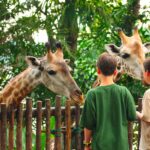We would be glad to share our Costa Rica expertise
Here are a few of our most commonly asked questions. We’re here to clear doubts; if you don’t see your question here, send us an email, we would love to talk to you!
Most popular is to travel during the dry season from half November to the end of April when normally the weather is less rainy. However traveling in the rainy season is also possible. Most of the rains are concentrated in intense showers in the afternoon. This means that with an early start you can still have a very productive day. The advantage of traveling in the rainy season is that hotel prices tend to be less and it gets less crowded.
Yes ! Rainy season lasts from beginning of May until half November but does not mean that it rains constantly. Most rains are concentrated in afternoon intense showers of an hour or two. So with an early start you can still have very productive and fun days.
It helps and is really appreciated by the locals. But if you don’t know Spanish you won’t have any problem. Most people at hotels and restaurants and all of the local guides you will meet will be fluent in English. We would like to encourage you to learn at least some words in order to have basic interactions like “gracias”: thank you, “buenos dias”: good morning and “Pura vida”: meaning literally “pure life” but Pura Vida really has many meanings…Pura Vida is the good answer to any question really and will for sure be returned by a smile ! Try it !
Birdwatching is good during the whole year. Members of typical neotropical families like Toucans, Motmots, Trogons, Antbirds, Jacamars, Manakins, Parrots and macaws and Woodcreepers are resident and can be seen in the country during the whole year. In addition to the resident birds Costa Rica receives a large quantity of birds that come to winter from the North. These species include some raptors, herons, many species of shorebirds and many species of Warblers and Vireos. The northern migrants will arrive or migrate through Costa Rica from the north around September – October. Some species stay to winter in the country. Other continue their journey further to South America. In March April there is an opposite migration movement when those migratory species go back to their breeding grounds.
Yes of course…we would be glad to offer you an itinerary designed based on your specific needs and whishes. The itineraries we offer on our website are meant to give you an idea of the prices and of what is possible. It is not problem to modify any of the sample itineraries the way you want.
With some basic precautions driving in Costa Rica is safe. If you rent a car in Costa Rica we highly recommend to not leave valuables when you park your car and always park your car in designated safe parking areas. Traffic can be dense in the big cities of the Central Valley, but once you leave the big cities the traffic will become much less and driving becomes more relaxing. Driving your own rental car will give you the freedom to stop where you want and as long as you want during your traveling. We will equip your rental car with a router that generates free Wi-Fi, which will allow you to find your way using navigation apps like Google maps or Waze. In addition to that we will also provide you with a detailed road description. However if you do not feel comfortable driving your own rental car we would be happy to offer you private transportation.
Birds are everywhere in Costa Rica, so it is hard to choose. The advantage of Costa Rica is that there are many species of birds and different bird habitats concentrated in a relatively small area.
Resplendent Quetzal is a bird from the highlands and can be seen year round. The Resplendent Quetzal rely heavily on wild avocado trees or aguacatillo , found in Costa Rica ‘s highlands. A very reliable place to see Resplendent Quetzal is the San gerardo de Dota area. Please note that many males after breeding will loose their large tail coverts around May – June. Those large green ornamental feathers will start to grow back slowly and around October – November you can expect to see adult males again with their tail coverts more or less complete. So best time to see Resplendent Quetzals with long tails is from November to May.
As you will be in nature all the time automatically you will be able to enjoy other fauna and flora on your local tours. Tell your guide what animal or plant you want to see so he or she can take that into account. Other animals frequently seen on Costa Rica include 4 species of monkeys (Central American Spider Monkey, Mantled Howler Monkey, White-faced Capuchin Monkey and Central-American Squirrel Monkey), 2 species of sloths (Brown-throated Three-toed Sloth and Hoffman’s Two-toed Sloth), White-nosed Coatis, Central American Agouti’s. Also reptiles are frequently seen, especially in lowland areas like Spectacled Caimans, American Crocodile, Green Iguana, Black Spiny Iguana, Common and Emerald Basilisk. Snakes are often hard to find since they are normally well camouflaged. Among common seen amphibians are The Poisson Dart Frogs, Red-eyed Leaf-frog, Hourglass Frog and Giant Toad. Amphibians you can see more in humid lowlands like the Caribbean lowlands and South Pacific lowlands.
Yes of course. Please send us the list of most wanted bird species and we would be happy to help you design an itinerary based on that information.
Yes you can. We will adjust your itinerary to your preferred travel dates.
With Love Travel WordPress Theme you will have everything you need to create a memorable online presence. Start create your dream travel site today.
With Love Travel WordPress Theme you will have everything you need to create a memorable online presence. Start create your dream travel site today.

Discover the World, one Full Adventure at a Time!






1080 Brickell Ave - Miami
United States of America
info@travel.com
Travel Agency +1 473 483 384
Info Insurance +1 395 393 595